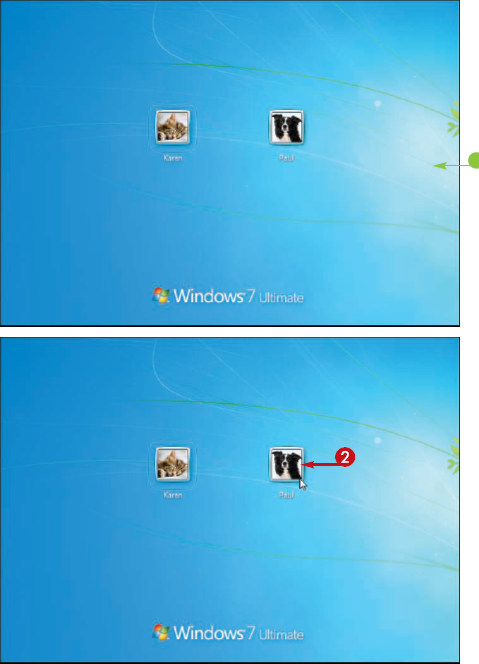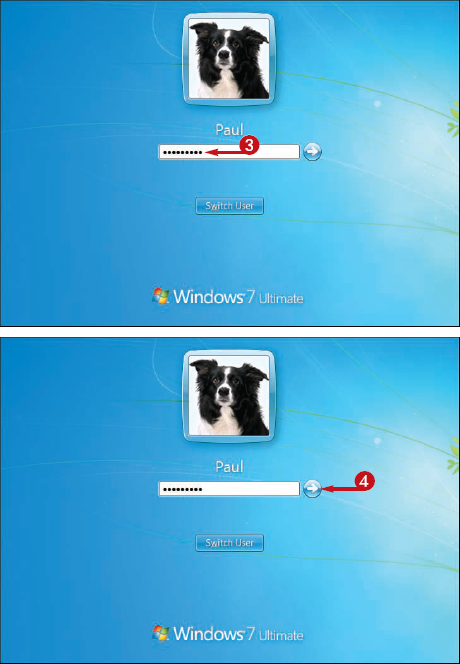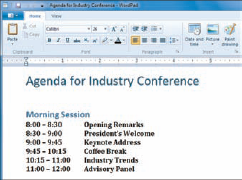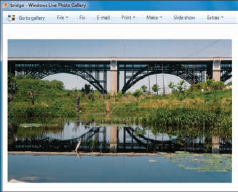1. Start Windows 7
When
you turn on your computer, Windows 7 starts automatically, but you may
have to navigate the Welcome screen along the way. You use the Welcome
screen to log in to Windows 7 using the user account and password you
configured when you first set up your computer.
If
this is the first time you are starting your computer, you will have to
run through a series of configuration steps. These steps configure your
main user account, your desktop background, and a few security options.
You should select the default options to ensure your computer remains
secure and up to date.
Start Windows 7
1 Turn on your computer.
• The Windows 7 Welcome screen appears.
NOTE
If
your version of Windows 7 is configured with just a single user and no
password, then you bypass the Welcome screen and go directly to the
desktop.
2 Click the icon that corresponds to your Windows 7 user name.
Windows 7 prompts you to enter your password.
NOTE
If you are the only user on your computer, Windows 7 prompts you for your password right away, so you can skip Step2

3 Type your password.
NOTE
The password characters appear as dots as you type them so that no one else can read your password.
4 Click the Go arrow ( ) or press
) or press  .
.
The Windows 7 desktop appears after a few moments.

What happens if I forget my Windows 7 password?
Most Windows 7 user accounts that are password protected are also set up with a password hint
— usually a word or phrase designed to jog your memory. You choose the
question when you set your password. If you forget your password, click the Go arrow( ) and then click OK to see the password hint.
) and then click OK to see the password hint.
2. What You Can Do with Windows 7
Windows
7 is an operating system that contains a collection of tools, programs,
and resources. You do not do anything directly with Windows 7 itself.
Instead, you use its tools and programs to perform tasks, including
getting your work done, creating pictures, editing photos, playing
music, surfing the World Wide Web, exchanging e-mail messages, and more.
Here is a sampling of what you can do with them.
Get Work Done
With Windows 7, you can run
programs that enable you to get your work done more efficiently, such as
a word processor for writing memos and letters, a spreadsheet for
making calculations, and a database for storing information. Windows 7
comes with some of these programs , and you can purchase and install others separately.

Create and Edit Pictures
Windows 7 comes with a lot of
features that let you work with images. You can create your own pictures
from scratch, import images from a scanner or digital camera, or
download images from the Internet. After you create or acquire an image,
you can edit it, print it, or send it via e-mail.

Play Music and Other Media
Windows 7 has treats for your
ears as well as your eyes. You can listen to audio CDs, play digital
sound and video clips, watch DVD movies, tune in to Internet radio
stations, and copy audio files to a recordable CD.

Get on the Internet
Windows 7 makes connecting to
the Internet easy. And after you are on the Net, Windows 7 has all the
tools you need to get the most out of your experience. For example, you
can use Internet Explorer to surf the World Wide Web and Windows Live Mail to send and receive e-mail .